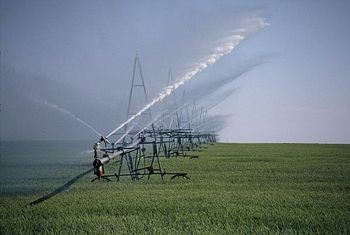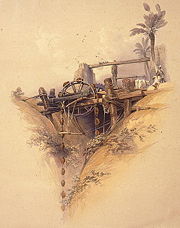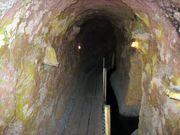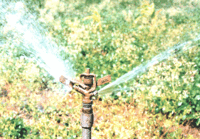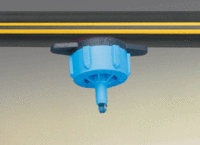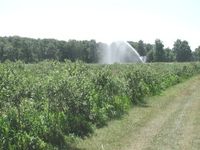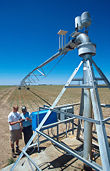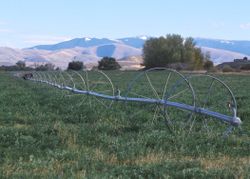Irrigation
2008/9 Schools Wikipedia Selection. Related subjects: Environment; Geography
Irrigation is the artificial application of water to the soil usually for assisting in growing crops. In crop production it is mainly used in dry areas and in periods of rainfall shortfalls, but also to protect plants against frost.
Additionally irrigation helps to suppress weed growing in rice fields. In contrast, agriculture that relies only on direct rainfall is referred to as rain-fed farming. Irrigation is often studied together with drainage, which is the natural or artificial removal of surface and sub-surface water from a given area.
Irrigation is also a term used in the Medical/Dental fields and refers to flushing and washing out anything with water or another liquid.
History
Archaeological investigation has identified evidence of irrigation in Mesopotamia and Egypt as far back as the 6th millennium BCE, where barley was grown in areas where the natural rainfall was insufficient to support such a crop.
In the Zana Valley of the Andes Mountains in Peru, archaeologists found remains of three irrigation canals radiocarbon dated from the 4th millennium BCE, the 3rd millennium BCE and the 9th century CE. These canals are the earliest record of irrigation in the New World. Traces of a canal possibly dating from the 5th millennium BCE were found under the 4th millennium canal. Sophisticated irrigation and storage systems were developed by the Indus Valley Civilization in Pakistan and North India, including the reservoirs at Girnar in 3000 BCE and an early canal irrigation system from circa 2600 BCE. Large scale agriculture was practiced and an extensive network of canals was used for the purpose of irrigation.
There is evidence of the ancient Egyptian pharaoh Amenemhet III in the twelfth dynasty (about 1800 BCE) using the natural lake of the Faiyum Oasis as a reservoir to store surpluses of water for use during the dry seasons, as the lake swelled annually as caused by the annual flooding of the Nile.
The Qanats, developed in ancient Persia in about 800 BCE, are among the oldest known irrigation methods still in use today. They are now found in Asia, the middle east and north Africa. The system comprises a network of vertical wells and gently sloping tunnels driven into the sides of cliffs and steep hills to tap groundwater. The noria, a water wheel with clay pots around the rim powered by the flow of the stream (or by animals where the water source was still), was first brought into use at about this time, by Roman settlers in North Africa. By 150 BCE the pots were fitted with valves to allow smoother filling as they were forced into the water.
The irrigation works of ancient Sri Lanka, the earliest dating from about 300 BCE, in the reign of King Pandukabhaya and under continuous development for the next thousand years, were one of the most complex irrigation systems of the ancient world. In addition to underground canals, the Sinhalese were the first to build completely artificial reservoirs to store water. The system was extensively restored and further extended during the reign of King Parakrama Bahu (1153 – 1186 CE).
The oldest known hydraulic engineers of China were Sunshu Ao (6th century BCE) of the Spring and Autumn Period and Ximen Bao (5th century BCE) of the Warring States period, both of whom worked on large irrigation projects. In the Szechwan region belonging to the State of Qin of ancient China, the Dujiangyan Irrigation System was built in 256 BCE to irrigate an enormous area of farmland that today still supplies water. By the 1st century AD, during the Han Dynasty, the Chinese also used chain pumps that lifted water from lower elevation to higher elevation. These were powered by manual foot pedal, hydraulic waterwheels, or rotating mechanical wheels pulled by oxen. The water was used for public works of providing water for urban residential quarters and palace gardens, but mostly for irrigation of farmland canals and channels in the fields.
In fifteenth century Korea the world's first water gauge, woo ryang gyae ( Korean: 우량계), was discovered in 1441 CE. The inventor was Jang Young Sil, a Korean engineer of the Choson Dynasty, under the active direction of the King, Se Jong. It was installed in irrigation tanks as part of a nationwide system to measure and collect rainfall for agricultural applications. With this instrument, planners and farmers could make better use of the information gathered in the survey.
Present extent
By the middle of the 20th century, the advent of diesel and electric motors led for the first time to systems that could pump groundwater out of major aquifers faster than it was recharged. This can lead to permanent loss of aquifer capacity, decreased water quality, ground subsidence, and other problems. The future of food production in such areas as the North China Plain, the Punjab, and the Great Plains of the US is threatened.
At the global scale 2,788,000 km² (689 million acres) of agricultural land was equipped with irrigation infrastructure around the year 2000. About 68% of the area equipped for irrigation is located in Asia, 17% in America, 9% in Europe, 5% in Africa and 1% in Oceania. The largest contiguous areas of high irrigation density are found in North India and Pakistan along the rivers Ganges and Indus, in the Hai He, Huang He and Yangtze basins in China, along the Nile river in Egypt and Sudan, in the Mississippi-Missouri river basin and in parts of California. Smaller irrigation areas are spread across almost all populated parts of the world.
Types of irrigation
Various types of irrigation techniques differ in how the water obtained from the source is distributed within the field. In general, the goal is to supply the entire field uniformly with water, so that each plant has the amount of water it needs, neither too much nor too little.
Surface irrigation
In surface irrigation systems water moves over and across the land by simple gravity flow in order to wet it and to infiltrate into the soil. Surface irrigation can be subdivided into furrow, borderstrip or basin irrigation. It is often called flood irrigation when the irrigation results in flooding or near flooding of the cultivated land. Historically, this has been the most common method of irrigating agricultural land.
Where water levels from the irrigation source permit, the levels are controlled by dikes, usually plugged by soil. This is often seen in terraced rice fields (rice paddies), where the method is used to flood or control the level of water in each distinct field. In some cases, the water is pumped, or lifted by human or animal power to the level of the land.
Localized irrigation
Localized irrigation is a system where water is distributed under low pressure through a piped network, in a pre-determined pattern, and applied as a small discharge to each plant or adjacent to it. Drip irrigation, spray or micro-sprinkler irrigation and bubbler irrigation belong to this category of irrigation methods.
Drip Irrigation
Drip irrigation, also known as trickle irrigation, functions as its name suggests. Water is delivered at or near the root zone of plants, drop by drop. This method can be the most water-efficient method of irrigation, if managed properly, since evaporation and runoff are minimized. In modern agriculture, drip irrigation is often combined with plastic mulch, further reducing evaporation, and is also the means of delivery of fertilizer. The process is known as fertigation.
Deep percolation, where water moves below the root zone, can occur if a drip system is operated for too long of a duration or if the delivery rate is too high. Drip irrigation methods range from very high-tech and computerized to low-tech and relatively labor-intensive. Lower water pressures are usually needed than for most other types of systems, with the exception of low energy centre pivot systems and surface irrigation systems, and the system can be designed for uniformity throughout a field or for precise water delivery to individual plants in a landscape containing a mix of plant species. Although it is difficult to regulate pressure on steep slopes, pressure compensating emitters are available, so the field does not have to be level. High-tech solutions involve precisely calibrated emitters located along lines of tubing that extend from a computerized set of valves. Both pressure regulation and filtration to remove particles are important. The tubes are usually black (or buried under soil or mulch) to prevent the growth of algae and to protect the polyethylene from degradation due to ultraviolet light. But drip irrigation can also be as low-tech as a porous clay vessel sunk into the soil and occasionally filled from a hose or bucket. Subsurface drip irrigation has been used successfully on lawns, but it is more expensive than a more traditional sprinkler system. Surface drip systems are not cost-effective (or aesthetically pleasing) for lawns and golf courses. In the past one of the main disadvantages of the subsurface drip irrigation (SDI) systems, when used for turf, was the fact of having to install the plastic lines very close to each other in the ground, therefore disrupting the turfgrass area. Recent technology developments on drip installers like the drip installer at New Mexico State University Arrow Head Centre, places the line underground and covers the slit leaving no soil exposed.
Sprinkler irrigation
In sprinkler or overhead irrigation, water is piped to one or more central locations within the field and distributed by overhead high-pressure sprinklers or guns. A system utilizing sprinklers, sprays, or guns mounted overhead on permanently installed risers is often referred to as a solid-set irrigation system. Higher pressure sprinklers that rotate are called rotors and are driven by a ball drive, gear drive, or impact mechanism. Rotors can be designed to rotate in a full or partial circle. Guns are similar to rotors, except that they generally operate at very high pressures of 40 to 130 lbf/in² (275 to 900 kPa) and flows of 50 to 1200 US gal/min (3 to 76 L/s), usually with nozzle diameters in the range of 0.5 to 1.9 inches (10 to 50 mm). Guns are used not only for irrigation, but also for industrial applications such as dust suppression and logging.
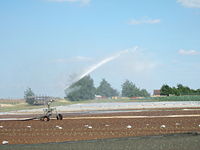
Sprinklers may also be mounted on moving platforms connected to the water source by a hose. Automatically moving wheeled systems known as traveling sprinklers may irrigate areas such as small farms, sports fields, parks, pastures, and cemeteries unattended. Most of these utilize a length of polyethylene tubing wound on a steel drum. As the tubing is wound on the drum powered by the irrigation water or a small gas engine, the sprinkler is pulled across the field. When the sprinkler arrives back at the reel the system shuts off. This type of system is known to most people as a "waterreel" traveling irrigation sprinkler and they are used extensively for dust suppression, irrigation, and land application of waste water. Other travelers use a flat rubber hose that is dragged along behind while the sprinkler platform is pulled by a cable. These cable-type travelers are definitely old technology and their use is limited in today's modern irrigation projects.
Centre pivot irrigation
Centre pivot irrigation is a form of sprinkler irrigation consisting of several segments of pipe (usually galvanized steel or aluminium) joined together and supported by trusses, mounted on wheeled towers with sprinklers positioned along its length. The system moves in a circular pattern and is fed with water from the pivot point at the centre of the arc. These systems are common in parts of the United States where terrain is flat.
Most centre pivot systems now have drops hanging from a u-shaped pipe called a gooseneck attached at the top of the pipe with sprinkler heads that are positioned a few feet (at most) above the crop, thus limiting evaporative losses. Drops can also be used with drag hoses or bubblers that deposit the water directly on the ground between crops. The crops are planted in a circle to conform to the centre pivot. This type of system is known as LEPA ( Low Energy Precision Application). Originally, most centre pivots were water powered. These were replaced by hydraulic systems ( T-L Irrigation) and electric motor driven systems (Lindsay, Reinke, Valley, Zimmatic, Pierce, Grupo Chamartin. Most systems today are driven by an electric motor mounted low on each span. This drives a reduction gearbox and transverse driveshafts transmit power to another reduction gearbox mounted behind each wheel. Precision controls, some with GPS location and remote computer monitoring, are now available.
Lateral move (side roll, wheel line) irrigation
A series of pipes, each with a wheel of about 1.5 m diameter permanently affixed to its midpoint and sprinklers along its length, are coupled together at one edge of a field. Water is supplied at one end using a large hose. After sufficient water has been applied, the hose is removed and the remaining assembly rotated either by hand or with a purpose-built mechanism, so that the sprinklers move 10 m across the field. The hose is reconnected. The process is repeated until the opposite edge of the field is reached. This system is less expensive to install than a center pivot, but much more labor intensive to operate, and it is limited in the amount of water it can carry. Most systems utilize 4 or 5-inch (130 mm) diameter aluminium pipe. One feature of a lateral move system is that it consists of sections that can be easily disconnected. They are most often used for small or oddly-shaped fields, such as those found in hilly or mountainous regions, or in regions where labor is inexpensive.
Sub-irrigation
Subirrigation also sometimes called seepage irrigation has been used for many years in field crops in areas with high water tables. It is a method of artificially raising the water table to allow the soil to be moistened from below the plants' root zone. Often those systems are located on permanent grasslands in lowlands or river valleys and combined with drainage infrastructure. A system of pumping stations, canals, weirs and gates allows it to increase or decrease the water level in a network of ditches and thereby control the water table.
Sub-irrigation is also used in commercial greenhouse production, usually for potted plants. Water is delivered from below, absorbed upwards, and the excess collected for recycling. Typically, a solution of water and nutrients floods a container or flows through a trough for a short period of time, 10-20 minutes, and is then pumped back into a holding tank for reuse. Sub-irrigation in greenhouses requires fairly sophisticated, expensive equipment and management. Advantages are water and nutrient conservation, and labor-saving through lowered system maintenance and automation. It is similar in principle and action to subsurface drip irrigation.
Manual irrigation using buckets or watering cans
These systems have low requirements for infrastructure and technical equipment but need high labor inputs. Irrigation using watering cans is to be found for example in peri-urban agriculture around large cities in some African countries.
Automatic, non-electric irrigation using buckets and ropes
Besides the common manual watering by bucket, an automated, natural version of this also exist. Using plain polyester ropes combined with a prepared ground mixture can be used to water plants from a vessel filled with water. The ground mixture would need to be made depending on the plant itself, yet would mostly consist of black potting soil, vermiculite and perlite. This system would (with certain crops) allow you to save expenses as it does not consume any electricity and only little water (unlike sprinklers, water timers, ...). However, it may only be used with certain crops (probably mostly larger crops that do not need a humid environment; perhaps e.g. paprika's).
Irrigation using stones to catch water from humid air
In countries where at night, humid air sweeps the countryside, stones are used to catch water from the humid air by transpiration. This is for example practiced in the vineyards at Lanzarote.
Dry terasses for irrigation and water distribution
In subtropical countries as Mali and Senegal, a special type of terrassing (without flood irrigation or intent to flatten farming ground) is used. Here, a 'stairs' is made trough the use of ground level differences which helps to decrease water evaporation and also distributes the water to all patches (sort of irrigation).
How an in-ground irrigation system works
Most commercial and residential irrigation systems are " in ground" systems, which means that everything is buried in the ground. With the pipes, sprinklers, and irrigation valves being hidden, it makes for a cleaner, more presentable landscape without garden hoses or other items having to be moved around manually.
Controllers, zones, and valves
Most Irrigation systems are divided into zones. A zone is a single Irrigation Valve and one or a group of sprinklers that are connected by pipes. Irrigation Systems are divided into zones because there is usually not enough pressure and available flow to run sprinklers for an entire yard or sports field at once. Each zone has a solenoid valve on it that is controlled via wire by an Irrigation Controller. The Irrigation Controller is either a mechanical or electrical device that signals a zone to turn on at a specific time and keeps it on for a specified amount of time. "Smart Controller" is a recent term used to describe a controller that is capable of adjusting the watering time by itself in response to current environmental conditions. The smart controller determines current conditions by means of historic weather data for the local area, a moisture sensor (water potential or water content), weather station, or a combination of these.
Sprinklers
When a zone comes on, the water flows through the lateral lines and ultimately ends up at the irrigation Sprinkler heads. Most sprinklers have pipe thread inlets on the bottom of them which allows a fitting and the pipe to be attached to them. The sprinklers are usually installed with the top of the head flush with the ground surface. When the water is pressurized, the head will pop up out of the ground and water the desired area until the valve closes and shuts off that zone. Once there is no more water pressure in the lateral line, the sprinkler head will retract back into the ground.
Problems in irrigation
- Competition for surface water rights.
- Depletion of underground aquifers.
- Ground subsidence (e.g. New Orleans, Louisiana)
- Increased soil salinity with consequent build up of toxic salts on soil surface in areas with high evaporation. This requires either leaching to remove these salts and a method of drainage to carry the salts away or use of mulch to minimize evaporation.
- Overirrigation because of poor distribution uniformity or management wastes water, chemicals, and may lead to water pollution.
- Deep drainage (from over-irrigation) may result in rising water tables which in some instances will lead to problems of irrigation salinity.
